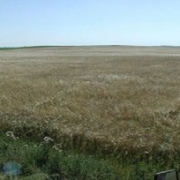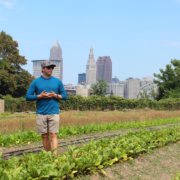Real Organic: Reflections on “The Deep Roots of Organic in Soil” by Paul Muller
 Print This Post
Print This Post
By Lee Rinehart, NCAT Agriculture Specialist
A review of a session at the EcoFarm 2023 Pre-Conference Session, Real Organic: Stories from the front lines
In the beginning, agricultural knowledge was passed hand to hand in a praxis of reciprocity. Robin Wall Kimmerer writes of this, and I’ll direct my reader to her for a deep dive into indigenous lifeways. For now, let that concept set the stage for our inquiry into the development of organic agriculture. I don’t know if there is a direct lineage between indigenous practice and organic agriculture, but there is certainly this idea of reciprocity that I can imagine plays a role.
Vandana Shiva once said organic farming is based on two principles: diversity and the law of return. Diversity is firmly set in our common lexicon and has become popularized in no small part because the USDA Natural Resources Conservation Service (NRCS) has adopted it as one of its soil health principles. The law of return, though, brings to my mind the idea of reciprocity. Miquel Altieri once suggested that an evolved, conscious human being is one whose attitude toward nature is that of coexistence, not exploitation. And Enrique Salmon wrote that indigenous people are aware that life is viable only when we view our surroundings—the land, animals, air, water, and soil—as kin, as relations, who each have roles that ensure mutual survival and well-being. We have to farm. We have to break the soil in order to plant crops. In nature, beings die for other beings to continue, and humans are a part of this ecology. There is a way of interacting with the land that has a history measured in tens of thousands of years and has its roots in indigenous practice. People had a relationship with their world that can best be described, in Kimmerer’s terms, as reciprocity.
Respect and reciprocity defined indigenous peoples’ relationship with the soil, plants, and animals they lived with and among. They saw other species as teachers to look to for guidance, since they’ve been on the earth far longer than we have been and have had time to figure things out (again, Kimmerer). When we love someone, we put them at the top of our priorities. When the land is approached with respect, as an entity in and of itself, we take what we need, and we return what the land needs to grow and thrive. This, I believe, is what Vandana Shiva meant.
Then, mechanization set in. Wendell Berry said it better than I can, so I will let him:
“Once, the governing human metaphor was pastoral or agricultural, and it clarified, and so preserved in human care, the natural cycles of birth, growth, death, and decay. But modern humanity’s governing metaphor is that of the machine. Having placed ourselves in charge of Creation, we began to mechanize both the Creation itself and our conception of it. We began to see the whole Creation merely as raw material, to be transformed by machines into a manufactured Paradise.
And so, the machine did away with mystery on the one hand and multiplicity on the other. The Modern World would respect the Creation only insofar as it could be used by humans. Henceforth, by definition, by principle, we would be unable to leave anything as it was. The usable would be used; the useless would be sacrificed in the use of something else. By means of the machine metaphor we have eliminated any fear or awe or reverence or humility or delight or joy that might have restrained us in our use of the world.”
This brings us fully to Paul Muller’s talk at EcoFarm. Paul, a co-owner and land steward at Full Belly Farm in northern California, suggests our thinking of land and soil has diverged; it has become more fragmented. Soil, indeed the land itself, is something deficient and not capable of supporting itself. Perhaps we can (the collective we here, not only small organic farmers and those who’ve internalized the regenerative ethic, but eaters, urban dwellers, corporate CEOs, politicians, and farmers who have through cultural conditioning bought into the chemical paradigm) look deeper. Maybe we can see we are not the center of the universe. That’s a good first step.
Paul spoke of the James Webb telescope as a metaphor that is useful. Probing deep into the cosmos with this powerful tool has revealed the depth and complexity and awe of the universe and has allowed us to juxtapose our own existence against the tapestry of the stars and see ourselves as finite. And, as well, to see our own lives as an expression of the universe originating from the elements boiled in distant stars. If we take this metaphor and point it down, we view the same cosmos we see when we look up.
The universe is in the soil. There are multitudinous species of microorganisms and relationships and complexity and there is a common language here of carbon. There is Shiva’s diversity. There is reciprocity in the cycles of carbon, hydrogen, and all the elements that constitute this incarnation of the universe. And human hands are a part of this cycle.
Organic farming had an intimation that this was there. Read Sir Albert Howard. Lady Balfour. F.H. King. Robert Rodale. And our more recent pioneers. E.F. Schumacher. Wendell Berry. Eliot Coleman. They encourage us to mimic the intelligence of native systems. We are shooting in the dark in many ways, but we see these things work. Contra the industrial recipe for farming, we solve for patterns, not for individual problems.
From the start, the organic movement has been striving for continuous improvement. By this, we mean less and less added inputs, as opposed to the input substitution championed by conventional organic agriculture. We mean farmer and farmworker autonomy, as opposed to worker exploitation. We mean animal welfare, as opposed to concentrated animal feeding operations. And we mean observation of patterns and lifeways, as opposed to prescriptions and the reductionism of agricultural science.
No one brings the point home better than Wendell, so I will let him speak again. “We don’t know what we are doing because we don’t know what we are undoing.”
Related ATTRA Resource:
Other Resources:
Braiding Sweetgrass: Indigenous Wisdom, Scientific Knowledge, and the Teachings of Plants
This blog is produced by the National Center for Appropriate Technology through the ATTRA Sustainable Agriculture program, under a cooperative agreement with USDA Rural Development. ATTRA.NCAT.ORG.



 NCAT
NCAT


